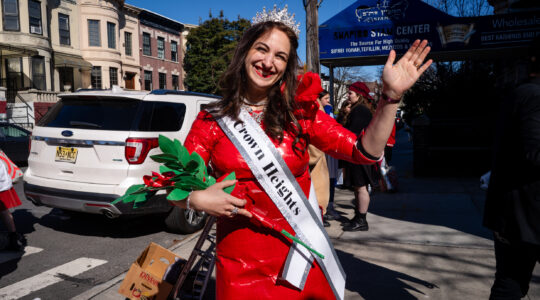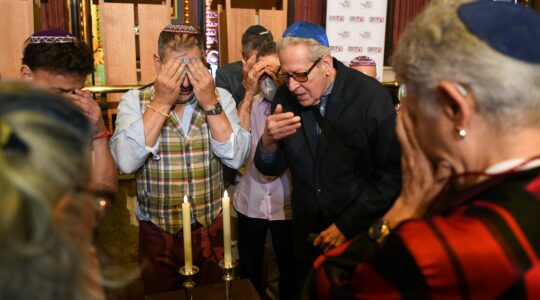Museum Mile — the stretch of Fifth Avenue from 82nd Street to 104th — offers an intriguing paradox this fall. The Jewish Museum, at the corner of 92nd Street, is presenting a retrospective of works by a Jewish painter who eschewed Jewish imagery in his embrace of the universal. A few blocks south, the National Academy of Design exhibits the work of a painter who rejected Judaism, but uses explicitly Jewish symbols as expressions of spiritual transcendence.
The artists, Adolph Gottlieb and Hyman Bloom, both came of age in the years following the Great Depression, as war engulfed Europe. The revelation of the human capacity for evil demanded an answer. As the exhibitions on Fifth Avenue show, each artist’s response became an artistic signature.
Adolph Gottlieb:
A Survey Exhibition
Sanford Hirsch, the executive director of the 25-year-old Adolph and Esther Gottlieb Foundation, was once asked on Israeli radio to speak about Jewish aspects of Adolph Gottlieb’s work.
“It’s going to be a very short program,” Hirsch recalls saying.
Gottlieb, who became a leading proponent of the Abstract Expressionists movement, was not interested in representing the specifics of his identity. Instead, in his distinctive canvases of Pictographs, Labyrinths, Imaginary Landscapes, Unstill Lifes and Bursts, Gottlieb pursued universal meaning.
“The idea of being a so-called Jewish artist is like being a professional Jew,” Gottlieb, who died in 1974, once said. “I think art is international and should transcend any racial, ethnic, religious or national boundaries.”
The Jewish Museum last put on an exhibition of Gottlieb’s work in 1957. The Museum was then a showplace for emerging artists, and the Gottlieb show was the first survey of an Abstract Expressionist artist’s work in a New York museum. At the time, Jewish identity was not dependent on the pursuit of Jewish themes, says curator Norman Kleeblatt. “Being openly Jewish meant having a certain kind of freedom to be who you were.”
From his youth, Gottlieb was a strong-willed person. Born in New York City in 1903, he left home at 17 and worked his way to Europe because, says Hirsch, he had decided to be an artist and wanted to be “where the center was.” Back home, from 1935 to 1940, he exhibited with a group called The Ten, whose ranks included Mark Rothko, who devoted themselves to expressionist and abstract painting.
“All the great hopes were demolished,” says Hirsch. The result of all the utopias promised by Socialism and science had resulted in mass destruction, “and they weren’t seeing that in American art anywhere. That’s what they were going for.”
In the early 1940s, Gottlieb and Rothko decided to find a new direction and turned to classical myths as the roots of Western civilization. In Oedipus (1941) and the pictographs that followed, Gottlieb mirrored the grid form of Attic vases and painted simple icons, highlighting the artist’s role as an image-maker, rather than storyteller or social commentator.
The pair wrote in a 1943 letter to the Art Editor of The New York Times, “We assert that the subject is crucial and only that subject matter is valid which is tragic and timeless.”
A tour through The Jewish Museum’s current exhibition of Gottlieb’s work, organized by Spain’s Institut Valencia d’Art Modern, shows that the artist continued to follow a personal agenda. While his contemporaries favored Manhattan, Gottlieb stayed in Brooklyn. When other Abstract Expressionist artists — including Rothko, Jackson Pollock, David Smith, Willem De Kooning and Barnett Newman — covered entire canvases, Gottlieb focused on the center, in works like “Sentinel” of 1951. Gottlieb was almost completely paralyzed by a stroke in 1970, but continued to work, creating some of the largest works of his 50-year career.
Color and Ecstasy:
The Art of Hyman Bloom
In 1941, Dorothy Miller, a curator at the Museum of Modern Art, visited the studio of Hyman Bloom, an artist recommended to her by the head of the Massachusetts Works Progress Administration, which had employed Bloom from 1935 to l940.
“We rang the bell a great many times,” Miller recalled in an oral history. “And finally Hyman stuck his head out of the second-floor window of this old house and said, ‘What do you want?’ ”
Miller wanted to see the Latvian-born painter’s work for possible inclusion in an upcoming exhibition, “Americans 1942: Eighteen Artists from Nine States.” Eventually, Bloom let Miller in, and then reluctantly agreed to show her a few of his paintings, all of which had been turned toward the walls. Two of those paintings, depictions of synagogue interiors, the art critic Matthew Baigell counts “among the most important paintings using Jewish themes ever painted.”
“Americans 1942” opened with 13 of Bloom’s works, including the synagogue paintings, but the reclusive artist declined to submit a statement for the catalogue.
Bloom’s aversion to the art world of dealers and gallery openings kept him out of the mainstream art scene, says Isabelle Dervaux, the curator of a new retrospective of 60 of Bloom’s works at the National Academy Museum. But it was precisely Bloom’s relative obscurity that prompted the artist-members of the National Academy to choose him as the first subject in a series of exhibitions devoted to older artists whose work has been overlooked. (Bloom, incidentally, did not attend the Oct.1 opening of “Color and Ecstasy.”)
Standing in front of “The Synagogue” (c. 1940), Dervaux explains that Bloom’s subject matter was a bold choice for the 1942 exhibition. The large canvas shows a crowded sanctuary filled with singing worshippers: at the front, a cantor lifts a Torah scroll heavenward and leans his head back, eyes closed and mouth wide. It is a moment of ecstasy, reflected in the radiant white lights of lamps and chandeliers.
“It was his most ambitious painting representing the Jewish faith,” Dervaux says. “That’s a very important statement in itself.”
Bloom, who was born in 1913 and moved with his family to Boston when he was seven, was raised in a strict Orthodox home. He rejected Jewish practice after becoming a bar mitzvah, “but remained a very, very spiritual person,” Dervaux says. “That was always a part of him.”
Bloom, who continues to work in a studio in Nashua, N.H., is a spiritual seeker. He became a Buddhist and attended meetings of the Rosicrucians. He experimented with LSD. He studied world music and learned to play the mandolin and the sitar.
A natural draftsman, Bloom was trained as an artist beginning in his teens, both at the Boston Museum of Fine Arts and, simultaneously, at a settlement house in Boston’s West End with Harold Zimmerman, whose unconventional technique — including, in part, working only from memory — guided Ball of Bloom’s subsequent work. As a young man, Bloom was struck by the works the Expressionists Chaim Soutine and Georges Rouault, whose intense treatment of color, texture and — in the case of Rouault, religious mysticism — he sought to imitate.
“Color and Ecstasy” reveals ways Bloom sought to represent transcendent experiences in his art. In the 1940s, he worked on paintings of synagogue chandeliers and lighted Christmas tress, works whose surreal quality had identified as one of the first “Abstract Expressionists.” But unlike those artists, Bloom persisted in doing figurative work. He then painted colorfully mottled corpses, detailed in the jewel-like manner of Gustav Klimt. Bloom did not mean to be gruesome, Dervaux explains. “He saw [death] as a path to new life.”
That theme repeats in new forms beginning in the 1950s: paintings of surgery or séances in the style of Old Masters; detailed drawings of the Maine woods; tangled fish skeletons or uncanny landscapes sprung from melting and dissolving human limbs. “Always the cycle of life and death in nature,” says Dervaux.
But throughout his career, Bloom has also painted self-portraits. In them, he is a rabbi—the fulfillment of a childhood ambition—holding a Torah and a prayer book. In one such portrait from 1942-44, the rabbi’s face and the scroll are ribbons of color. More recent canvases from 1999 are blurred images of loose, gestural brushwork. “It is a painting of the artist as an aspirational person,” says Dervaux.
“Adolph Gottlieb: A Survey Exhibition” runs through March 3 at The Jewish Museum, 1109 Fifth Ave., Man. (212) 423-3200. Sun., 10 a.m.-5:45 p.m.; Mon.-Wed., 11 a.m.-5:45 p.m.; Thu., 11 a.m.-8 p.m.; Fri., 11 a.m.-3 p.m. $8, $5.50. Pay what you wish Thursdays after 5 p.m. On Thu., Oct. 31, art historian Ann Marie Gibson will speak on “Criteria of Excellence in Abstract Expressionism,” an exploration of the context in which the work of Gottlieb and his peers came to prominence. “Color and Ecstasy: The Art of Hyman Bloom” runs through Dec. 29 at the National Academy Museum, 1083 Fifth Ave., Man. (212) 369-4880.
The New York Jewish Week brings you the stories behind the headlines, keeping you connected to Jewish life in New York. Help sustain the reporting you trust by donating today.




